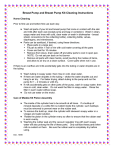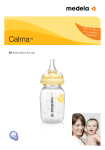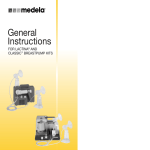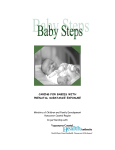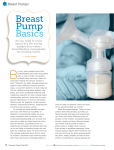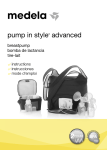Download Calma® - Medela
Transcript
Calma ® Instructions he revolutionary T new breastmilk feeding system Prior to First Use: Important Safeguards Cleaning & Care • • • Disassembly Read all instructions. Separate all parts. Boil by following the cleaning instructions in this manual. Intended Use Prior to first use and after each use. 1.Remove Calma from bottle by turning counter clockwise. Calma is for full term healthy infants and is not intended for premature or late pre-term infants. top Dear parents, Congratulations on your decision to choose Calma. For more than 50 years, Medela has pioneered innovative products which help to enhance babies’ health through the life enhancing benefits of breastmilk. With Calma you can trust in a product that has been developed on a well-established research foundation. This research has shown that with Calma, your baby is able to maintain the learned feeding behavior that your baby exhibits when breastfeeding. Your baby will continue to benefit from breastfeeding. However, if you are separated from your baby, Calma provides an excellent alternative that should not interfere with the breastfeeding relationship between you and your baby. The warning symbol identifies all instructions that are important to safety. Failure to observe these instructions can lead to injury or damage to the breastpump. When used in conjunction with the following words, the warning symbols stand for: WARNING Can lead to serious injury or death. CAUTION Can lead to minor injury. NOTE Can lead to material damage. INFO Useful or important information that is not related to safety. 2.Press base down. 3. Lift nipple from top and remove silicone nipple. Cleaning base lid 1.Rinse all separated parts in cool water to remove breastmilk. IMPORTANT: Plastic bottles and component parts become brittle when frozen and may break when dropped. Also, bottles and component parts may become damaged if mishandled, e.g. dropped, over-tightened, or knocked over. Take appropriate care in handling bottles and components. Do not use the breastmilk if bottles or components become damaged. 5.Gently remove parts from water with tongs and place on a clean surface. 6.Allow all separated parts to air dry in a clean area. Storing Parts It is important to clean Calma after every feed. Caution: • Always use this product under adult supervision. • All parts that are not in use must be kept out of children’s reach. • Never use nipple as a pacifier. • Continuous and prolonged sucking of fluids can cause tooth decay. • Inspect for damage before each use. Replace at the first signs of damage or weakness. 4.Carefully drop parts into boiling water, and boil for 10 minutes. Medela’s Quick Clean™ Micro-Steam™ bag can be used as an alternate to boiling. To locate a Medela retailer visit www.breastfeedingnationalnetwork.com. cap nipple 3.Fill the pot with water and bring to a boil. Make sure all parts are completely dry before storing. When parts are not in use, put in clean plastic bag or store in a container with a lid. Alternatively, the parts can be wrapped in clean paper or cloth towel. Do NOT store wet or damp parts. Assembly Calma can be assembled in a hygienic way. 2.Wash all separated parts in warm, soapy water.* 3.Rinse all separated parts with clear water. 4.Allow all separated parts to air dry in a clean area. Note: You can also wash all separated parts on top rack of dishwasher. 2.Place the silicone 1. Wash hands with soap and water prior nipple onto top by turning the bottom to handling. edge upwards. *It is not recommended to use a bottle brush with Calma. Caution: Do not leave feeding parts in direct sunlight or heat, as this may weaken or damage parts. Sanitizing 3.Flip the edges of the silicone nipple down. In addition to cleaning, Calma can be sanitized once per day by boiling: 1.Separate all parts. To purchase a replacement: • Locate a Medela retailer at www.breastfeedingnationalnetwork.com. • Email [email protected], or • Call 1-800-435-8316 2.Choose a pot that is large enough so parts DO NOT rest on the sides or bottom while boiling. 4.Insert the top onto the base. 5.Lid can be used on bottom of Calma and on bottle for storage. Using Calma Your baby will prefer and benefit from breastfeeding, so breastfeed your baby whenever you are together. For those times you are separated from your baby we recommend you use Calma exclusively and not with other nipples when feeding your baby from a bottle. If your baby has already used another nipple, be aware, that with Calma, the milk flow is controlled by the interaction of your baby’s sucking action and the milk-flow control system. This is different than with any other nipple – you may need a bit of patience and persistence. It may take a little time for Calma to be accepted by your baby. Remember this is the first time that your baby will come in contact with an artificial product instead of the familiar breast. Everything is new for your baby and he or she cannot smell you and your milk as with breastfeeding. Medela wishes you and your baby all the best! Breastfeeding must be well established before introducing a nipple. We recommend using Calma exclusively from the first bottle feeding and only for breastmilk. 1.Feeding with Calma. Position the baby in a different way than when feeding at the breast (e.g. sit the baby in a baby chair facing the caregiver). This helps your baby to learn a new way to feed and makes it easier to switch from breast to Calma and back again. 2.Yes, it is the right length! Even if you think Calma looks a bit too long, don’t worry, it is the perfect length. Your nipple lengthens up to 2 times in your baby’s mouth while breastfeeding. As such, Calma was designed to reach a similar spot in your baby’s mouth as the breast. It is, however, important that your baby has the right latch-on position. Correct latch-on position To encourage your baby to open his/her mouth to take Calma, stimulate the lip as you would with breastfeeding. 3.Did you know that your baby has to do some work? During breastfeeding, milk does not flow automatically. To facilitate milk flow, your baby has to create a vacuum. This is the same with Calma. Your baby has to work to build up a vacuum for milk to flow. Storing and Handling Breastmilk Prior to storing and handling, refer to the Breastmilk Storage Guidelines for Healthy Term Babies (check with your local WIC agency for specific storage instructions, if needed). •Wash hands before pumping milk. With Calma •You can warm your milk by standing the bottle briefly in warm water or holding under running warm water. Care must be taken to keep the cap dry. • Thawed milk must be refrigerated after thawing and used within 24 hours. Do not refreeze. • Prior to feeding, make sure the entire bottle is defrosted and the milk is gently swirled to mix. Room Temperature •Pumped milk can be stored in a bottle with a solid lid or a disposable breastmilk storage bag. 4–6 hours at 66–78 °F (19–26 °C) 24 hours at 59 °F (15 °C) References: www.BreastmilkGuidelines.com •If you do not use your pumped milk within 4-6 hours, label bottles with the date the milk was pumped and refrigerate or freeze it. More about Calma •When freezing your milk, only fill containers up to ¾ full because milk expands with freezing. •Chill your freshly expressed milk before adding it to already frozen milk. •If you need to transport your breastmilk, for example to the baby’s caregiver, use a cooler with three (3) frozen ice packs. This will help keep your milk cold until you reach your destination (up to 24 hours). Thawing and Warming Breastmilk Prior to thawing and/or warming, refer to the Breastmilk Storage Guidelines for Healthy Term Babies (check with your local WIC agency for specific storage instructions, if needed). Caution: Never microwave breastmilk either to defrost or warm it. Microwaving milk may create “hot spots.” There is always a risk of hot spots, which can burn your baby. Microwaving can also change the composition of your milk. Where does the milk come from? The milk flows through the small hole at the rate that is controlled by the interaction of your baby’s vacuum and the milk-flow control system. Compressing the nipple will not result in any milk flow. You can be confident your baby will be able to get enough milk based on his own nursing pattern. (For Healthy Term Babies) •Use clean pump kit and bottles every time you pump. •Do not store breastmilk in the door of the refrigerator. Calma does not drip! You can turn Calma upside down and it still won’t drip. Your baby needs to apply a certain level of vacuum in order to get milk out. (However, it is possible that there is some dripping of milk out of the nipple at the end of the feed if baby gets off the nipple before drinking the portion of milk just drawn from the bottle.) Freshly Expressed Breastmilk Storage Guidelines Cooler with 3 Frozen Ice Packs •It is recommended to thaw breastmilk in the refrigerator overnight. At breast •Milk can be thawed quickly in container of warm water (not over 37° C/98° F), making sure that the water does not touch the lid. Once milk is liquid and still chilled, dry off the container and refrigerate until use. Do not thaw frozen milk in a microwave or in a pan of boiling water. Refrigerator Freezer Thawed Breastmilk 3–8 days at 39 °F or lower (4 °C) 6–12 months 0–4 °F (-18–-20 °C) use within 24 hrs Size is right You might not believe it, but one size is sufficient. Your nipples stay the same over the course of your lactation. The flow, shape and length of Calma are designed to suit your baby’s needs as your baby grows. Calma was designed to meet your baby’s needs during the entire breastfeeding experience. Your baby has time to breathe Your baby has a unique sucking pattern, including pauses to swallow and breathe. By using Calma, your baby is able to feed and pause naturally according to his/her personal rhythm. This helps to slow down the feed and results in a calm and relaxed baby both during and after the feed. Can Calma help avoid gassiness? Calma helps avoid gassiness as the bottle is vented through our unique air control system. Unlike many other vented bottles Calma vents air independent of how it is assembled. Why is the hole at the tip of the nipple so wide? Only the milk that passes through the milk-flow control system will flow into the baby’s mouth. The wide hole makes the nipple soft, flexible and adaptable to your baby. www.medela.com Medela, Inc. 1101 Corporate Drive McHenry, IL 60050, USA Ph: (800) 435-8316 / (815) 363-1166 Fax: (815) 363-1246 Email: [email protected] Medela and Calma are registered trademarks of Medela Holding AG. Quick Clean and Micro-Steam are trademarks of Medela, Inc. 1908243 C 0313 © 2013 Medela, Inc.


